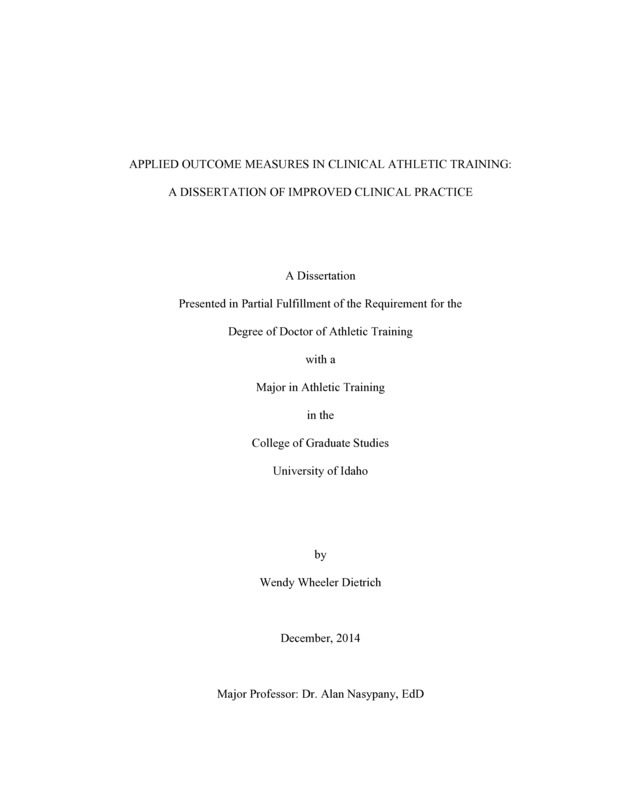APPLIED OUTCOME MEASURES IN CLINICAL ATHLETIC TRAINING: A DISSERTATION OF IMPROVED CLINICAL PRACTICE
Wheeler Dietrich, Wendy. (2014). APPLIED OUTCOME MEASURES IN CLINICAL ATHLETIC TRAINING: A DISSERTATION OF IMPROVED CLINICAL PRACTICE. Theses and Dissertations Collection, University of Idaho Library Digital Collections. https://www.lib.uidaho.edu/digital/etd/items/wheelerdietrich_idaho_0089e_10098.html
- Title:
- APPLIED OUTCOME MEASURES IN CLINICAL ATHLETIC TRAINING: A DISSERTATION OF IMPROVED CLINICAL PRACTICE
- Author:
- Wheeler Dietrich, Wendy
- Date:
- 2014
- Keywords:
- Athletic Training Outcome measures
- Program:
- Movement & Leisure Sciences
- Subject Category:
- Health sciences
- Abstract:
-
Outcomes measures are essential to produce and evaluate evidence-based practice and understanding quality recovery in an active population. Healthcare professionals such as Athletic Trainers are well versed in the collection and analysis of patient-oriented and dis-ease-oriented measures to improve patient care. Outcome measures offer a method of evaluation for treatment of hamstring injury such as the box tape. The purpose of this research was to determine the effectiveness of outcome measures to evaluate the box tape on low-grade hamstring injuries.
The two-part study includes a survey distributed to a sample of the National Athletic Trainers' Associations certified membership and a clinical research investigation using out-come measures collected during the application of a hamstring treatment technique. Out-come measures including pain at best and worst, range of motion, Global Rating of Change (GRC), the Disablement of the Physically Active Scale (DPAS), were analyzed to determine correlation to return to participation of hamstring injured patients treated with the box tape. Thirty-four percent of respondents indicated they were "Not too confident" with outcomes measures, and seventeen percent of respondents indicated they were "Not at all" confident with outcomes measures. Forty-six percent stated they were "Not at all familiar" with patient-oriented outcomes. The mean number of days no participation was 5.9 with a standard error of 1.29. The mean DPAS scores (F= 6.242, P=0.004), deficit in ROM (F= 19.345, P=.000), pain at worst (F= 4.536, P= 0.016), pain at best (F= 6.327, P= 0.004) and the GRC (F=5.254, P=.010) were significantly different for patients categorized as "no participation," "limited participation" and "full participation."
The results from the survey illustrate the enigmatic nature of outcomes measures in athletic training. Patient outcomes were significantly different between those who were ` and those who were able to participate indicating the patient-oriented outcomes, pain, GRC and DPAS combined with disease-oriented evidence such as range of motion are valuable in evaluating injury recovery.
- Description:
- doctoral, D.A.T., Movement & Leisure Sciences -- University of Idaho - College of Graduate Studies, 2014
- Major Professor:
- Nasypany, Alan
- Committee:
- Seegmiller, Jeffrey; Parker, Paula M; Shotwell, Colleen A
- Defense Date:
- 2014
- Identifier:
- WheelerDietrich_idaho_0089E_10098
- Type:
- Text
- Format Original:
- Format:
- application/pdf
- Rights:
- In Copyright - Educational Use Permitted. For more information, please contact University of Idaho Library Special Collections and Archives Department at libspec@uidaho.edu.
- Standardized Rights:
- http://rightsstatements.org/vocab/InC-EDU/1.0/

